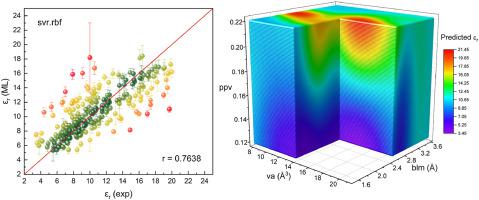Journal of Materiomics ( IF 8.4 ) Pub Date : 2021-03-04 , DOI: 10.1016/j.jmat.2021.02.012 Jincheng Qin , Zhifu Liu , Mingsheng Ma , Yongxiang Li

|
Low permittivity microwave dielectric ceramics (MWDCs) are attracting great interest because of their promising applications in the new era of 5G and IoT. Although theoretical rules and computational methods are of practical use for permittivity prediction, unsatisfactory predictability and universality impede rational design of new high-performance materials. In this work, based on a dataset of 254 single-phase microwave dielectric ceramics (MWDCs), machine learning (ML) methods established a high accuracy model for permittivity prediction and gave insights of quantitative chemistry/structure-property relationships. We employed five commonly-used algorithms, and introduced 32 intrinsic chemical, structural and thermodynamic features which have correlations with permittivity for modeling. Machine learning results help identify the permittivity decisive factors, including polarizability per unit volume, average bond length, and average cell volume per atom. The feature-property relationships were discussed. The optimal model constructed by support vector regression with radial basis function kernel was validated its superior predictability and generalization by verification dataset. Low permittivity material systems were screened from a dataset of ∼3300 materials without reported microwave permittivity by high-throughput prediction using optimal model. Several predicted low permittivity ceramics were synthesized, and the experimental results agree well with ML prediction, which confirmed the reliability of the prediction model.
中文翻译:

微波介电陶瓷介电常数预测和合理设计的机器学习方法
低介电常数微波介电陶瓷(MWDC)因其在 5G 和物联网新时代的广阔应用前景而备受关注。尽管理论规则和计算方法可用于介电常数预测,但不令人满意的可预测性和通用性阻碍了新型高性能材料的合理设计。在这项工作中,基于 254 个单相微波介电陶瓷 (MWDC) 的数据集,机器学习 (ML) 方法建立了用于介电常数预测的高精度模型,并提供了定量化学/结构-性能关系的见解。我们采用了五种常用算法,并引入了 32 种与介电常数相关的固有化学、结构和热力学特征,用于建模。机器学习结果有助于确定介电常数的决定性因素,包括每单位体积的极化率、平均键长和每个原子的平均细胞体积。讨论了特征属性关系。径向基函数核支持向量回归构建的最优模型通过验证数据集验证了其优越的可预测性和泛化能力。通过使用最佳模型的高通量预测,从约 3300 种材料的数据集中筛选出低介电常数材料系统,但没有报告微波介电常数。合成了几种预测的低介电常数陶瓷,实验结果与ML预测吻合较好,证实了预测模型的可靠性。和每个原子的平均细胞体积。讨论了特征属性关系。径向基函数核支持向量回归构建的最优模型通过验证数据集验证了其优越的可预测性和泛化能力。通过使用最佳模型的高通量预测,从约 3300 种材料的数据集中筛选出低介电常数材料系统,但没有报告微波介电常数。合成了几种预测的低介电常数陶瓷,实验结果与ML预测吻合较好,证实了预测模型的可靠性。和每个原子的平均细胞体积。讨论了特征属性关系。径向基函数核支持向量回归构建的最优模型通过验证数据集验证了其优越的可预测性和泛化能力。通过使用最佳模型的高通量预测,从约 3300 种材料的数据集中筛选出低介电常数材料系统,但没有报告微波介电常数。合成了几种预测的低介电常数陶瓷,实验结果与ML预测吻合较好,证实了预测模型的可靠性。通过使用最佳模型的高通量预测,从约 3300 种材料的数据集中筛选出低介电常数材料系统,但没有报告微波介电常数。合成了几种预测的低介电常数陶瓷,实验结果与ML预测吻合较好,证实了预测模型的可靠性。通过使用最佳模型的高通量预测,从约 3300 种材料的数据集中筛选出低介电常数材料系统,但没有报告微波介电常数。合成了几种预测的低介电常数陶瓷,实验结果与ML预测吻合较好,证实了预测模型的可靠性。











































 京公网安备 11010802027423号
京公网安备 11010802027423号